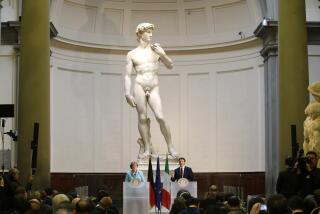In March, 1987, art historian Frederick Hartt...
In March, 1987, art historian Frederick Hartt announced the discovery of a small stucco torso which he believed to be Michelangelo’s model for his famous “David.” Now, in DAVID--BY THE HAND OF MICHELANGELO: THE ORIGINAL MODEL REDISCOVERED (Abbeville Press: $37.50; 144 pp.; color and black-and-white photography throughout), Hartt--with the assistance of photographer David Finn--defends his identification.
The badly damaged torso measures just over 20 centimeters. But by removing size cues from photographs of it and matching photographs of the “David,” Finn succeeds in making the similarity of the two visually almost beyond argument. But could the figurine not be a copy rather than a model?
Hartt says that it could not be, for there are subtle disparities between it and the “David” as well as striking similarities. (See above: the torso set into a sketch reconstructing its original appearance.) The disparities, Hartt argues, are deliberate, not of the sort that a copyist would inadvertently introduce.
The provenance of the torso is a romance and a mystery in itself. Reference to a model for the David first appears in 1553. In 1690, however, fire devastated a portion of the Palazzo Vecchio, and the model, now burned and broken, was lost. In 1921, the torso shown in the book was acquired by the Swiss composer Arthur Honegger, who kept it on his piano as he composed his oratorio, “King David.”
More to Read
The biggest entertainment stories
Get our big stories about Hollywood, film, television, music, arts, culture and more right in your inbox as soon as they publish.
You may occasionally receive promotional content from the Los Angeles Times.










